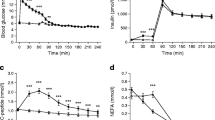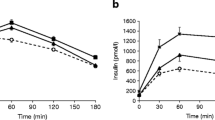Abstract
Glucose clamp experiments have shown that patients with reactive postprandial hypoglycaemia (PRH) frequently have an increased glucose disposal, but the relative involvement of insulin sensitivity (SI) and glucose effectiveness (Sg) in this process remains unknown. The minimal model approach was used to compare 13 patients in whom moderate reactive hypoglycaemia (<3.3 mmol) had been previously diagnosed and 13 matched controls. The intravenous glucose tolerance test (IVGTT, 0.5 g/kg glucose IV) with 0.02 U/kg insulin given at the 19th min and frequent sampling over 180 min shows that PRH patients exhibit a higher glucose tolerance coefficient Kg (2.99±0.26 vs 2.19±0.12;P<0.02), higher SI [22.9±6.4 vs 7.18±0.14 min−1/(μU/ml) · 10−4;P<0.01] and higher Sg (3.84±0.35 vs 2.92±0.79 min−1 · 10−2;P<0.05). The increase in Sg is explained by an increase in its component basal insulin effectiveness (BIE: 1.2±0.27 min−1 · 10−2 in PRH subjects vs 0.58±0.07;P<0.05) rather than an increase in Sg at zero insulin. The increase in BIE results from the high values of SI. In 4 PRH subjects SI and Sg were within the normal range, and the increase in Kg evidenced in the 9 others was explained by an increase in SI alone in 3 cases, in Sg alone in 1 case, and both SI and Sg in 5 cases. Thus, in sedentary subjects, the previously reported rise in tissue glucose assimilation is mainly explained by an increased insulin-mediated glucose disposal rather than non-insulin-mediated glucose disposal.
Similar content being viewed by others
References
Cahill GJ Jr, Soeldner JS, A non-editorial on non-hypoglycaemia. N Engl J Med 291:905–906, 1974
Yager J, Young RT, Non-hypoglycaemia is an epidemic condition. N Engl J Med 291:907–908, 1974
Charles MA, Hofeldt F, Shackelford A, Comparison of oral glucose tolerance tests and mixed meals in patients with apparent idiopathic post-absorptive hypoglycaemia. Diabetes 30:465–470, 1981
Harris S, Hyperinsulinism and dysinsulinism. JAMA 83:729–733, 192
Lev Ran A, Anderson RW, The diagnosis of postprandial hypoglycaemia. Diabetes 30:996–999, 1981
Lefèbvre PJ, Andreani D, Marks V, Creutzfeld W, Statement on postprandial hypoglycaemia. Diabetes Care 11:439–440, 1988
Palardy J, Havrankova J, Lepage R, Matte R, Bélanger R, D'Amour P, Ste-Marie LG, Blood glucose measurements during symptomatic episodes in patients with suspected postprandial hypoglycaemia. N Engl J Med 321:1421–1425, 1989
Brun JF, Fédou C, Bouix O, Raynaud E, Orsetti A, Evaluation of a standardized hyperglucidic breakfast test in postprandial reactive hypoglycaemia. Diabetologia 38:494–501, 1995
Hofeldt F, Reactive hypoglycaemia. Metabolism 24: 1193–1208, 1975
Lefebvre PJ, Hypoglycemia or non-hypoglycemia. In: Rifkin H, Colwell JA, Taylor SI (eds) Diabetes 1991. Proceedings of the 14th International Diabetes Federation Congress, Washington DC, June 1991. Excerpta Medica, Amsterdam, pp 757–761, 1991
Luyckx AS, Lefebvre PJ, Plasma insulin in reactive hypoglycaemia. Diabetes 20:435–442, 1971
Tamburrano G, Leonetti F, Sbraccia P, Giaccari A, Locuratolo N, Lala A, Increased insulin sensitivity in patients with idiopathic reactive hypoglycemia. J Clin Endocrinol Metab 69:885–890, 1989
Bergman RN, Toward physiological understanding of glucose tolerance. Minimal model approach. Diabetes 38:1512–1527, 1989
Brun JF, Boegner C, Orsetti A, Le minimal model: un nouvel outil pour l'étude des hypoglycémies du sportif. Science Sports 9:47–49, 1994
Bouix O, Brun JF, Orsetti A, The magnitude, the kinetics and the metabolic efficiency of first-phase insulin response to intravenous glucose are related. Horm Metab Res 25:312–316, 1993
Steil GM, Bergman RM. Reduced sampling for the minimal model estimate of insulin sensitivity from the modified and standard frequently sampled IVGTT (Abstract) Diabetes 40 [Suppl 1]: 38A, 1991
Ward GM, Weber KM, Walters IM, Aitken PM, Lee B, Best JD, Boston RC, Alford FP, A modified minimal model analysis of insulin sensitivity and glucose-mediated glucose disposal in insulin-dependent d diabetes. Metabolism 40:4–9, 1991
Brun JF, Guintrand-Hugret R, Boegner C, Bouix O, Orsetti A, Influence of short submaximal exercise on parameters of glucose assimilation analyzed with the minimal model. Metabolism 44:833–840, 1995
Kahn SE, Bergman RN, Schwartz RS, Taborsky GJ Jr, Porte D Jr, Short-term hyperglycaemia and hyperinsulinaemia improve insulin action but do not alter glucose action in normal humans. Am J Physiol 262:E518-E523, 1992
Kahn SE, Prigeon RL, McCulloch DK, Boyko EJ, Bergman RN, Schwartz MW, Neifing JL, Ward K, Beard JC, Palmer JP, Porte DJ Jr, Quantification of the relationship between insulin sensitivity and β-cell function in human subjects. Diabetes 42: 1163–1672, 1993
Foniciello M, Leonetti F, Giaccari A, Iozzo P, Pastore L, Merli E, Riggio O, Giovanetti P, Tamburrano G, Increased non oxidative glucose metabolism and energy expenditure in idiopathic reactive hypoglycemia (abstract). Diabetologica 35 [Suppl 1]: A187, 1992
Johnson DD, Dorr KE, Swenson WM, Service FJ, Reactive hypoglycaemia. JAMA 243:1151–1155, 1980
Blackman JD, Towle VL, Sturis J, Lewis GF, Spire JP, Polonsky KS, Hypoglycemic thresholds for cognitive dysfunction in IDDM. Diabetes 41:392–399, 1992
Cox DJ, Gonder-Frederick L, Clarke W, Driving decrements in type I diabetes during moderate hypoglycaemia. Diabetes 42:239–243, 1993
Boyle P, Schwartz N, Shah S, Clutter W, Cryer P, Plasma glucose concentrations at the onset of hypoglycaemic symptoms in patients with poorly controlled diabetes and in nondiabetes. N Engl J Med 318:1487–1492, 1988
Hogan MJ, Service FJ, Shar Brougu FW, Gerich E, Oral glucose tolerance test compared with a mixed meal in hypoglycaemia. A caveat on simulation. Mayo Clinic Proc 58:491–496, 1983
Heller S, Herbert M, McDonald I, Tattersall R, Influence of sympathetic nervous system on hypoglycaemic warning symptoms. Lancet 2:259–263, 1987
Mitrakou A, Ryan C, Veneman T, Mokan M, Jenssen T, Kiss I, Durrant J, Cryer P, Gerich J, Hierarchy of glycaemic thresholds for counterregulatory hormone secretion, symptoms, and cerebral dysfunction. Am J Physiol 260 (Endocrinol Metab 23):E67-E74, 1991
Vea H, Jorde R, Sager G, Vaaler S, Sundsfjord J, Reproducibility of glycaemic thresholds for activation of counterregulatory hormones and hypoglycaemic symptoms in healthy subjects. Diabetologia 35:958–961, 1992
Author information
Authors and Affiliations
Rights and permissions
About this article
Cite this article
Brun, J.F., Bouix, O., Monnier, J.F. et al. Increased insulin sensitivity and basal insulin effectiveness in postprandial reactive hypoglycaemia. Acta Diabetol 33, 1–6 (1996). https://doi.org/10.1007/BF00571932
Received:
Accepted:
Issue Date:
DOI: https://doi.org/10.1007/BF00571932




